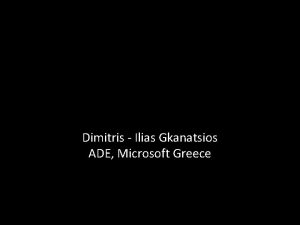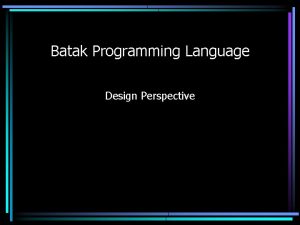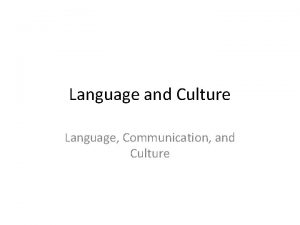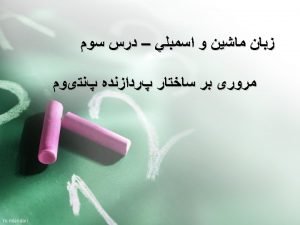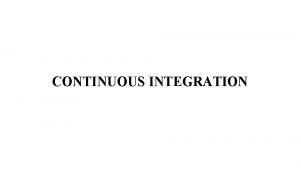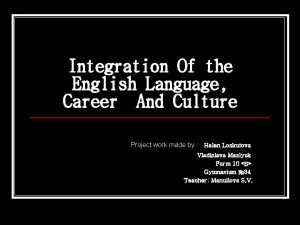Language Culture Integration of Language and Culture Introduction


























- Slides: 26

Language & Culture

Integration of Language and Culture

• Introduction Foreign language study expands the linguistic area of experience by affecting language comparisons. It also offers insights into another culture and as such it is concerned with the human social area of experience.

In language teaching and learning ‘culture’ is usually defined pragmatically. It is the culture associated with a language being learnt (Byram. 1989). Therefore, language will be regarded as a mechanism of cultural transmission promoting the values against those of the regions to which it is exported; consequently countries adopting EFL will make these countries perceptual consumers of the knowledge and value systems in it (Philipson. 1992).

Throughout the course, the learners can be encouraged to view the familiar from a different angle, not least in terms of people's behaviour, and thereby widen horizons and breakdown feelings of insularity. Teaching culture and cultural studies might follow the following pattern: a descriptive analysis of culture associated with language of study and as a series of statements about culture phenomenon exemplified in the home and foreign cultures.

The ultimate guidance objective of cultural studies in foreign language teaching makes a substantial contribution to learner's personal development and general education. If such guidance is not present, cultural studies will never rise above listing and learning of «typical differences» and haphazard of daily life and simplistic geography and history. (Byram. 1989)

• However, language advisors suggest that strong awareness of the dangers of cultural contamination implicit in the learning of a dominant international language, thus they have reacted into different ways according to age and objectives of the learners.

- The first response to contextualize the target language in the student's own region and culture. The implicit argument is that a culture does not exist in the core of language, but in its movable background and can be changed like scenery of a play. (Philipson. 1992. 52)

- The second is to perceive scientific, financial or technological knowledge as a value free because the majority of advanced language learners are supposed to join the world of teaching.

• Buttjes (1982) identifies three basic elements related to civilizations and culture studies.

• Pragmatic communicative oriented -teaching about the culture which is intended to alleviate problems of communication in the language, when the learner visits the foreign country.

• To give the learners a critical understanding of the foreign people, of their own view and their values. ( ideological understanding )

• Critical understanding: encouraging learners to go beyond more acceptances of particular historical development and present social situations as inevitable and unalterable, to respond critically, analytically and as a consequence, to analyse their own social environment with critical understanding. (Political action – oriented).

Culture Learning Objectives • Promoting learners' familiarity with the culture and civilizations of the country where the language which they are learning is spoken. • Promoting acquisition of an open-minded and a positive disposition towards unfamiliar culture • Assisting learners to develop a better understanding of their own identity and culture.

What basic elements should be considered while teaching civilisations or culture studies in Buttjes’ opinion?

Course content and analysis Modern content designers propose a model that caters not only for the content to be taught but also the implication of learners’ awareness. Any culture teaching should consider not only the spheres of activity and consciousness of the learners to verbal and non verbal interaction, but also the explicit information about the country or the countries where the foreign language is spoken.

The context gained much attention from experts in culture learning and teaching, and they propose a seven criteria model that largely deals with treatment of the context. • Factual accuracy and contemporarity of information in culture studies. • The avoidance or at least relativisation of stereotypes by making learners conscious of them. • The presentation of a realistic picture not one which implies the foreign society in a problem free. • Freedom from or at least the questioning of ideological tendencies in the material. • The presentation of the historical material; its relevance to understanding contemporary society should be explicit, • and it should be made clear that they are the product of the age.

• Possible culture teaching objectives • Teaching the culture or about the foreign culture associated to the language being learnt covers different dimensions that are integral in a language classroom. • A course would be of high expectancy if it considers not only knowledge, but also skills and attitudes that should be enhanced.

• Knowledge dimensions: • a-Provide information about the history, geography and political conditions of the language culture. (Culture / culture) • b- Provide information about daily life and routines. (Culture) • c- Provide information about shared values and beliefs. (Culture/ culture) • d-Provide experiences with a rich variety of cultural expressions (literature, theatre…)

• Attitudinal dimension Develop attitudes of openness and tolerance towards other people and cultures.

• Skills dimension • a - Promote reflections on cultural differences. • Promote increased understanding of students' culture. • The effect culture teaching has on students and the way they are affected by the process 'culture' cannot only be read, it has to be seen, heard and experienced — stimulation.

• Updating • Information about remote events tend to create a feeling of disgust among learners, so learners should be put in touch with the novelties and hot events for these current events tend to initiate and stimulate good discussions.

• Culture learning Implications at Algerian universities • Since any language is the vehicle of transmission of the culture associated to it and it is its mode of description and analysis, culture cannot be excluded from any course design of any foreign language teaching and learning. Any learner, especially at an advanced level should have enough knowledge about the milieu where the language he/ she is learning has evolved

A debate has always haunted educators about what to integrate as foreign cultural elements in their classrooms and what objectives to set behind such integration. The question that has always been raised is should we teach foreign culture associated with the foreign language or teach foreign civilization that the foreign language describes?

Since the aims behind such courses is to learn contextualized language, the influence of culture on the language being learnt , the particular aspects that differentiate the learner’s society from his or her, culture learning should be regarded very fundamental by any learner and considered as a content that promotes reflective study and analytical understanding of foreign societies.

The end of lecture three
 Forward integration and backward integration
Forward integration and backward integration Vertical diversification example
Vertical diversification example Simultaneous integration example
Simultaneous integration example Culture includes
Culture includes Fed-batch
Fed-batch American culture vs indian culture
American culture vs indian culture Stab and stroke culture
Stab and stroke culture Folk culture and popular culture venn diagram
Folk culture and popular culture venn diagram Examples of mass culture
Examples of mass culture Tsi
Tsi Folk culture and popular culture venn diagram
Folk culture and popular culture venn diagram Lawn culture method
Lawn culture method Carpet culture method
Carpet culture method Surface culture deep culture and esol
Surface culture deep culture and esol Principles of data integration
Principles of data integration Introduction to data integration
Introduction to data integration Sociologists define a symbol as
Sociologists define a symbol as Batch culture vs continuous culture
Batch culture vs continuous culture Collectivistic cultures
Collectivistic cultures Sub culture group
Sub culture group In an inert organizational culture,
In an inert organizational culture, Characteristics of quality culture
Characteristics of quality culture Gkanatsios
Gkanatsios Language integration
Language integration Language integration
Language integration Language integration
Language integration Types of pearl culture
Types of pearl culture






















